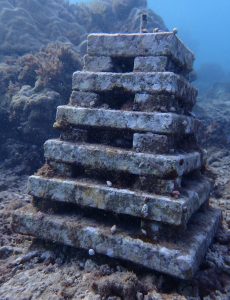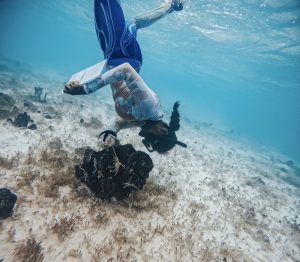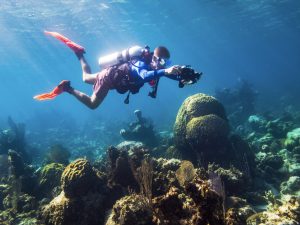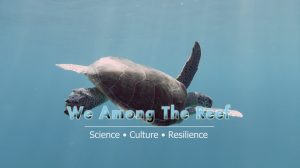by Stanton Charlton, Communications Specialist at PIMS
For several months now, the world has become familiar with the increasing ferocity of COVID-19. Stony Coral Tissue Loss Disease (SCTLD) may be equally threatening, if not moreso, to Caribbean coral reefs. After confirming its spread to Grand Bahama in March, we can now also confirm that this threat has made its way to New Providence.
Montastrea cavernosa (large-cup star coral)Infected with SCTLD at all six sites© Hayley-Jo Carr (PIMS & Reef Rescue Network)
SCTLD was first sighted off Miami’s coast in 2014 and provoked increasing discussion of how to contain its spread. Over the past 2-3 years, SCTLD became a more significant threat, and efforts to contain it were unsuccessful. The disease infected coral reefs in Mexico, Belize, Puerto Rico, the Dominican Republic, the Turks and Caicos Islands, the U.S. Virgin Islands, Saint Martin and Saint Eustacius.By the time SCTLD was confirmed in Grand Bahama in March, the Perry Institute for Marine Science scheduled a webinar explaining its significance to the public. Following the April 13th webinar, we implemented a mechanism to report SCTLD and encouraged participants to share potential sightings.On June 4th, 2020, we were able to investigate SCTLD reports that were shared with us. Six sites were surveyed between Columbus Cove and Lighthouse Boulders.The presence of SCTLD was confirmed at all six sites.
Pseudodiploria strigosa (symmetrical brain coral)Infected with SCTLD at all six sites© Hayley-Jo Carr (PIMS & Reef Rescue Network)
After counting 1,257 corals, we found that 37% of them had become infected with SCTLD. Based on initial rapid assessments, 11 species of coral have SCTLD in New Providence. Of the 11 species, the following were most commonly infected:
- Montastrea cavernosa (large-cup star coral)
- Pseudodiploria strigosa (symmetrical brain coral)
- Dilporia labryinthiformis (grooved brain coral)
- Pseudodilporia clivosa (knobby brain coral)
- Orbicella annualaris (lobed star coral)
Dipoloria labyrnthiformis (grooved brain coral)Infected with SCTLD at: Traveler’s, Sandyport, Baha Mar and Lighthouse Boulders© Hayley-Jo Carr (PIMS & Reef Rescue Network)
It is worth noting that infection rates did vary across the six sites, but Sandyport and sites to the east had the highest infection rates.The discovery of SCTLD on New Providence could have serious implications for the coral reef population for our entire archipelago.According to Dr. Krista Sherman, PIMS Senior Scientist, “Nassau, is the hub for the country and if we are unable to effectively contain SCTLD here, it is likely to spread to other islands. Given the significance of reefs to the environment and our economy, this would be devastating.”The proximity of SCTLD to the Nassau Harbour presents an urgent need for action to protect healthy reefs from the disease. Based on the data we have now, we believe vessels commuting between Grand Bahama, New Providence and Florida may have expedited the spread of SCTLD.This discovery presents an ideal opportunity to aggressively contain the disease. If we miss this opportunity, the consequences may be severe for Bahamian reefs. Like COVID-19, SCTLD spreads quickly. However, SCTLD’s deadliness to coral reefs is even more alarming.“Not since diving after Hurricane Matthew back in 2016 have I seen such devastation on our coral reefs around Nassau. This disease is moving so fast and every coral infected appears to not survive at all, with 100% mortality of the colony occurring,” said Hayley-Jo Carr, Training Director & Coordinator at PIMS’s Reef Rescue Network. “On the reefs infected, you can literally just leapfrog from one infected coral colony to the next. It’s an extremely upsetting situation and one that is going to have a disastrous effect on our already suffering coral reefs if actions are not taken swiftly to combat its spread.”Given the significance of this threat, we are leading research efforts and working with local partners, such as Bahamas National Trust, to effectively respond.
New Providence SCTLD rapid assessment team from left to right – Hayley-Jo Carr and Dr. Krista Sherman (Perry Institute for Marine Science), Shelley-Cant Woodside and Pachancia Knowles (Bahamas National Trust)
“We are working with partners to develop and implement strategies to mitigate the impacts of SCTLD to reefs and will be integrating this work into our coral reef research, monitoring and restoration program moving forward,” Dr. Sherman said.So, what can you to stop the spread of SCTLD and protect our reefs?
- Limit how the disease is transported by humans by disinfecting bilge water and dive/snorkel gear between dive sites using a mild bleach solution of hydrogen peroxide-based disinfectant.
- Commercial ships must properly exchange ballast water by to prevent spreading the disease.
- Report new locations where corals are showing signs of the disease. If we catch it early on a reef, we can prevent its spread to other corals on the reef.
Click here to download our complete report on SCTLD in New Providence.

Unveiling Coral Reef Biodiversity: Insights from ARMS Monitoring Structures
An ARM teeming with new coral recruits and a diversity of marine life, highlighting reef recovery and biodiversity Understanding Coral Reef Biodiversity Most new PhDs

7 Essential Insights from COP16: Tackling Coral Reef Conservation Challenges Amid Climate Change
United #ForCoral: Experts, advocates, and leaders from across the globe join forces at COP16 for the #ForCoral conference, hosted by the International Coral Reef Initiative.

Fieldwork Wrap-Up: Strengthening MPA Management in The Bahamas
Marine protected areas (MPAs) are critical tools in the conservation of marine species and habitats, safeguarding reefs, seagrasses, and mangroves that provide vital ecosystem services

Coral Reef Monitoring with Photogrammetry: A New Era in Reef Health Assessment
Coral reefs are some of the most biodiverse ecosystems on the planet, providing crucial habitat for marine life and protecting coastal regions from erosion. Yet,

Watch “We Among the Reef:” A Documentary on the Abaco Barrier Reef
The Perry Institute for Marine Science invites you to watch “We Among the Reef,” a compelling documentary that illuminates the significance of the Abaco Barrier

Guardians of the Deep: With Training from PIMS, Key Government Staff Become PADI Certified Divers
Akehia Thompson (DMR), Quetta Gibson (DMR), and Gilles Deal (DEPP) share a moment of camaraderie in their scuba gear, embarking on their training journey with



